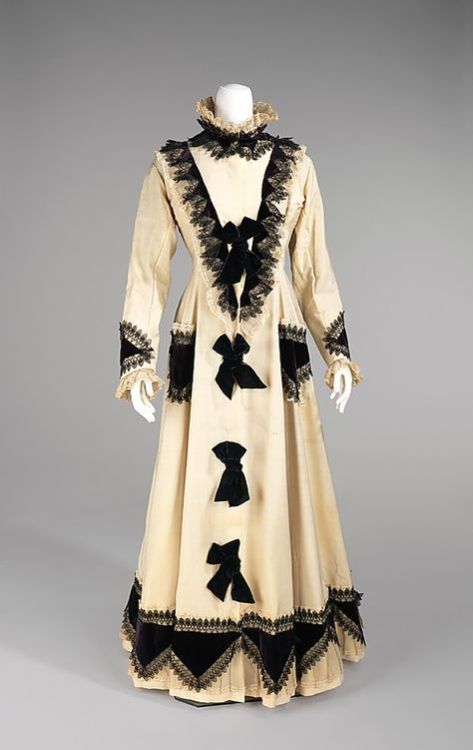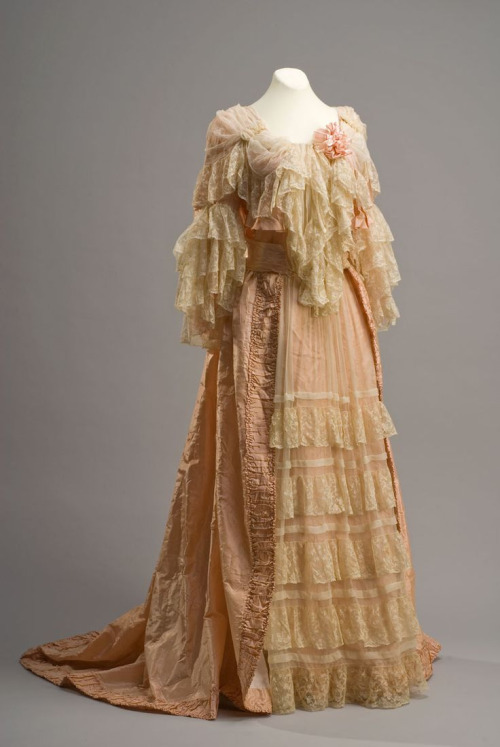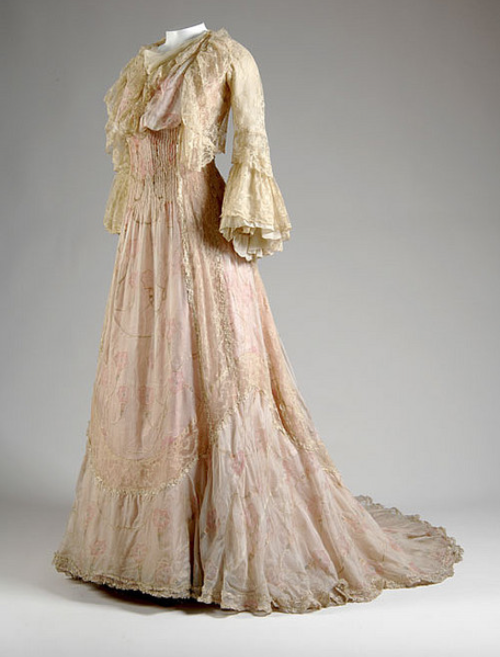It’s FRIDAY FASHION FACT! If you have been reading this blog for a while, you’ll know th
It’s FRIDAY FASHION FACT! If you have been reading this blog for a while, you’ll know that one of my favorite aspects of fashion history is the influence of society on dress. I can’t believe I haven’t written about today’s topic yet, since it is one of the best examples of this! We’re talking tea gowns!Tea gowns rose to popularity in the late 1870s, reaching widespread popularity throughout the late 19th to early 20th centuries. To put it simply, a tea gown is an informal garment worn in the house- you guessed it- at tea time, though later they were worn at dinnertime as well. What is so interesting about tea gowns is that their creation was a direct result of the rapidly changing society of the time. The Industrial Revolution led to a dramatic rise in urbanization. Naturally, this congested setting shifted social customs. Increased social circles meant increased social obligations. Visiting a friend or acquaintance for tea quickly became one of the most popular social calls, namely because it was the shortest. Custom dictated that one would not stay for more than half an hour for tea. The short time frame meant a less formal atmosphere.On a different note, during this same time, there was a strong Asian influence on design. Due to the 1868 Meiji Restoration, trade lines between Japan and Europe opened up, bringing a steady stream of Japanese goods to the Western world. Using these pieces, homes were decorated in the exotic style. Kimonos also held a fascination among the Victorians, many adopting them as dressing gowns. Women would commonly host members of their wide social circles in their homes (particularly the parlors) to show off their creative interpretation of Asian and exotic inspired design. So how does this all connect to the tea gown?To begin with, women desired a specific garment for these new abridged social calls- something relatively informal, yet still fashionable. Tea gowns have been described as a blend between a dressing gown and an evening gown. They were a far more relaxed style than the majority of fashions at the time. They were often loose fitting, and were often worn without the usual restrictive shapewear- namely bustles and (gasp!) corsets. Naturally, this meant that tea gowns were a very controversial garment, with many condemning them as lewd and immoral. Of course, many women who were so accustomed to wearing corsets still wore them with tea gowns, but disguised it with a loose bodice. Since they were so relaxed, though, a lady would never leave the house in a tea gown. As a result, only the hostess would wear one, while guests would wear afternoon or visiting gowns. One of the biggest appeals of the loose tea gown was that they were so easy to put on, and a lady could dress herself without the help of a lady’s maid. While the structure of tea gowns were simple, though, their design was anything but. Women pulled inspiration from the exotic into their gowns, often aiming to match the design of their parlors. There was also a strong historical influence in many tea gowns. Watteau pleats, the cape/train-like pleats used in 18th century robes a la française, were a popular design element. Some tea gowns would be made to look like two garments, a faux-robe over a dress. As with all fashions of the day, ladies would show off their wealth through their tea gowns, using rich fabrics, lace trims, ruffles, and other embellishments. As fashion developed, so did the tea gown. By the Edwardian Age, the popular tea gown style was incorporated into other forms of afternoon dress, to the point that tea gowns became difficult to distinguish from other styles of dress. As society changed throughout the 1920s and ‘30s and the custom of calling for tea time shifted, the tea dress slowly faded from popularity, vanishing altogether by World War II. It just goes to show how the life and death of a fashion can all be directly related to shifts in society!Have a question about fashion history that you want answered in the next FRIDAY FASHION FACT? Just click the ASK button at the top of the page! -- source link
#fashion facts#fashion history#dress history#victorian#victorian era#victorian fashion#victorian dress#edwardian fashion#edwardian#edwardian dress#edwardian era#tea gown#tea dress#history#clothing history#social history#long reads#long post#fashion#japonism#japanese influence#asian-inspired#meiji restoration









